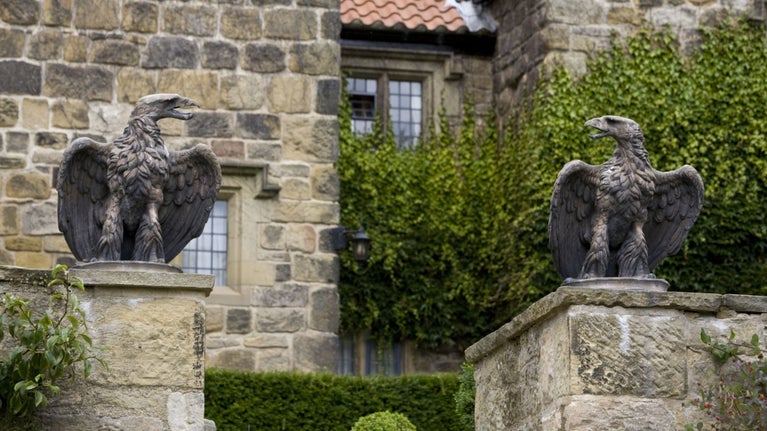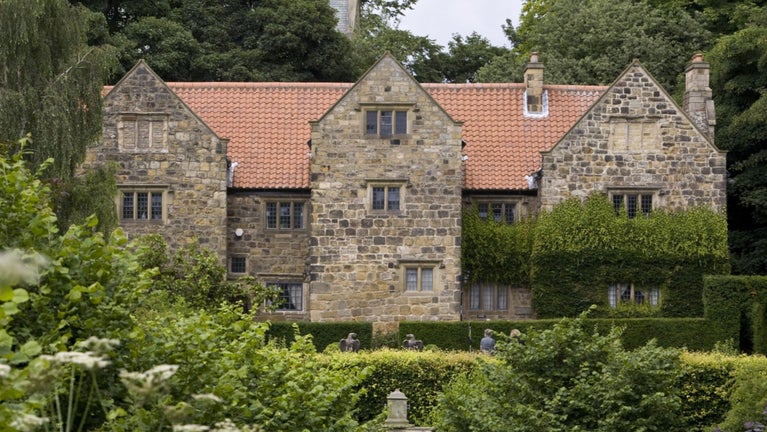
Discover more at Washington Old Hall
Find out when Washington Old Hall is open, how to get here, the things to see and do and more.

Washington Old Hall is in Washington Village in Tyne and Wear. In the 12th and 13th centuries, it was home to the Lords of the Manor of Wessyngton who were the ancestors of the first United States president, George Washington. Today, Washington Old Hall celebrates its American connection and remembers those who once lived within its walls.
The first historical record of Washington Old Hall is from the early 12th century, when it was known as Wessyngton Manor and owned by the Bishop of Durham. Around 1180, William de Hertburne (1160–94) exchanged his tenancy of Hartburn, County Durham, for the manor of Wessyngton. With Wessyngton his new home, William assumed 'de Wessyngton' as his new surname, as was the custom.
The Wessyngtons continued to rent the manor from the Bishops of Durham for seven generations. In 1402, Eleanor de Wessyngton (1370–1451) married Sir William Tempest (c. 1373–1441) of Studley Royal, and the tenancy transferred to the Tempest family.
The family tree of George Washington (1732–99), first president of the US, can be traced all the way back to the Wessyngtons who once lived at Washington Old Hall. George Washington is descended from Robert de Wessyngton I (c. 1273–1324), the second son of Sir William de Wessyngton III.
In around 1292 Robert de Wessyngton I left Wessyngton and married Joan de Strickland, heiress of Carnforth, Lancashire. In the 15th century their descendants adopted a new spelling of their name, and Wessyngton became Washington. Lawrence Washington settled in Northamptonshire in the 16th century, building Sulgrave Manor between 1539 and 1560. Lawrence's descendant, Colonel John Washington, emigrated to Virginia in 1656. John's great-grandson was George Washington.
The building that the Wessyngtons and the Tempests lived in survived into the 17th century. In 1613, William James, Bishop of Durham (1542–1617) purchased Washington Manor and with it the hall. The purchase was a settlement for James’s youngest, son Francis (1601–61). It was Francis who altered the hall into the building that we recognise today. He incorporated some elements of the medieval hall built by the Wessyngtons into a new two-story building, sometime before 1645.
Parts of the original hall are still visible to this day, including the pointed arches at the west end of the Great Hall.

In 1645, William James (1622–62), Francis’s son, moved into the new hall with his wife Dorothy (1620–1701). When William died in 1662, he left the manor to his only surviving son, William, who in turn died just one year later. The manor was then split between the four surviving sisters – Sarah, Dorothy, Elizabeth and Anne – and passed to their husbands’ estates on their marriages.
With the ownership of the hall and estate split between many people, this was the beginning of the end for Washington as a relatively wealthy manor estate.
During the 18th century the hall was let out and during the 19th century it was split into several separate dwellings. By the 1890s these tenements housed over 30 people from nine families, and the building fell into disrepair. In 1932, it was condemned as unsafe for people to live in and in 1933 it closed. At this point, it was highly likely that it would be demolished.

It was through the efforts of local headmaster Frederick Hill (1885–1955) and other members of the Washington Old Hall Preservation Committee that the hall was eventually saved. They raised the funds to purchase it in 1937 and began to plan for the restoration. The Second World War disrupted the plans, and work was delayed after the war by shortages and spiraling costs.
The building finally opened on 28 September 1955. Fred Hill was too ill to attend and died a few months later. Washington Old Hall was transferred to the National Trust with the assistance of Washington Urban District Council in 1956.
Although the link to George Washington may be distant, the restoration of the building would not have succeeded without the support of American donations. In 1977, then US President Jimmy Carter visited Washington Old Hall, helping to cement the relationship that the local community continues to have with the United States of America.
Washington became a New Town in 1964 and now forms part of the City of Sunderland. The old village and the hall remain as a reminder of their once rural history. The garden of the hall and the adjoining nuttery are an oasis for wildlife and people alike.
Arbuckle, Sheila, Frederick Hill and Washington Old Hall (Friends of Washington Old Hall, 2005).
Johnson, Margot, The Washington Family in Britain (Turnstone Venture, 2008).
Tillbrook, Michael, ‘James, William (1542–1617), Bishop of Durham’, Oxford Dictionary of National Biography, 2008.
George Washington's Family | George Washington's Mount Vernon, accessed 13 October 2025.

Find out when Washington Old Hall is open, how to get here, the things to see and do and more.
Washington Old Hall is affectionately known as the ‘little gem’ of the community, and its walls hold countless tales from those who called it home or visited through the years. Learn about the history of the Hall through the stories of local people.

Explore the manor house, home to the original Washington family, and enjoy colourful nature-rich gardens. Find out all the things to see and do here.

Discover everything you need to know about volunteering at historic Washington Old Hall, including what volunteers do, what’s in it for you and how to get involved.

Learn about people from the past, discover remarkable works of art and brush up on your knowledge of architecture and gardens.

From landscape gardeners to LGBTQ+ campaigners and suffragettes to famous writers, many people have had their impact on the places we care for. Discover their stories and the lasting legacies they’ve left behind.
